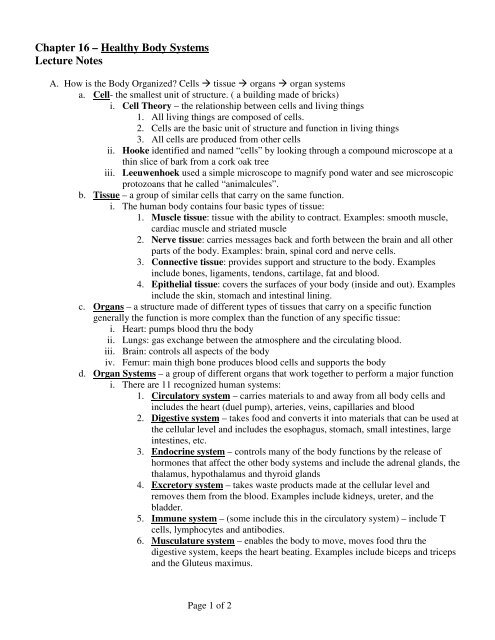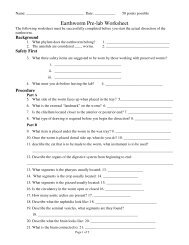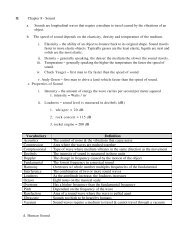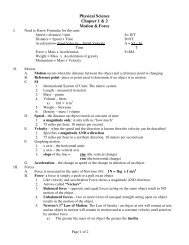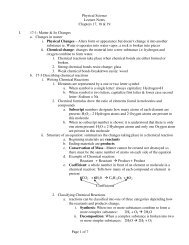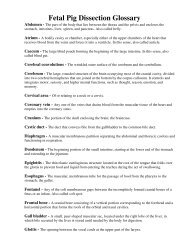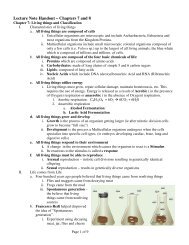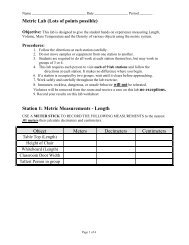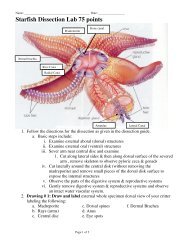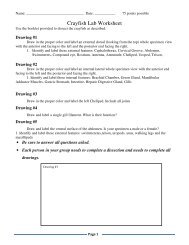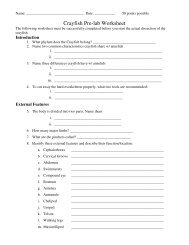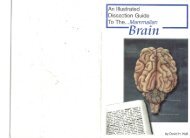Chapter 16 â Healthy Body Systems Lecture Notes - Mr.E Science
Chapter 16 â Healthy Body Systems Lecture Notes - Mr.E Science
Chapter 16 â Healthy Body Systems Lecture Notes - Mr.E Science
You also want an ePaper? Increase the reach of your titles
YUMPU automatically turns print PDFs into web optimized ePapers that Google loves.
<strong>Chapter</strong> <strong>16</strong> – <strong>Healthy</strong> <strong>Body</strong> <strong>Systems</strong><br />
<strong>Lecture</strong> <strong>Notes</strong><br />
A. How is the <strong>Body</strong> Organized Cells tissue organs organ systems<br />
a. Cell- the smallest unit of structure. ( a building made of bricks)<br />
i. Cell Theory – the relationship between cells and living things<br />
1. All living things are composed of cells.<br />
2. Cells are the basic unit of structure and function in living things<br />
3. All cells are produced from other cells<br />
ii. Hooke identified and named “cells” by looking through a compound microscope at a<br />
thin slice of bark from a cork oak tree<br />
iii. Leeuwenhoek used a simple microscope to magnify pond water and see microscopic<br />
protozoans that he called “animalcules”.<br />
b. Tissue – a group of similar cells that carry on the same function.<br />
i. The human body contains four basic types of tissue:<br />
1. Muscle tissue: tissue with the ability to contract. Examples: smooth muscle,<br />
cardiac muscle and striated muscle<br />
2. Nerve tissue: carries messages back and forth between the brain and all other<br />
parts of the body. Examples: brain, spinal cord and nerve cells.<br />
3. Connective tissue: provides support and structure to the body. Examples<br />
include bones, ligaments, tendons, cartilage, fat and blood.<br />
4. Epithelial tissue: covers the surfaces of your body (inside and out). Examples<br />
include the skin, stomach and intestinal lining.<br />
c. Organs – a structure made of different types of tissues that carry on a specific function<br />
generally the function is more complex than the function of any specific tissue:<br />
i. Heart: pumps blood thru the body<br />
ii. Lungs: gas exchange between the atmosphere and the circulating blood.<br />
iii. Brain: controls all aspects of the body<br />
iv. Femur: main thigh bone produces blood cells and supports the body<br />
d. Organ <strong>Systems</strong> – a group of different organs that work together to perform a major function<br />
i. There are 11 recognized human systems:<br />
1. Circulatory system – carries materials to and away from all body cells and<br />
includes the heart (duel pump), arteries, veins, capillaries and blood<br />
2. Digestive system – takes food and converts it into materials that can be used at<br />
the cellular level and includes the esophagus, stomach, small intestines, large<br />
intestines, etc.<br />
3. Endocrine system – controls many of the body functions by the release of<br />
hormones that affect the other body systems and include the adrenal glands, the<br />
thalamus, hypothalamus and thyroid glands<br />
4. Excretory system – takes waste products made at the cellular level and<br />
removes them from the blood. Examples include kidneys, ureter, and the<br />
bladder.<br />
5. Immune system – (some include this in the circulatory system) – include T<br />
cells, lymphocytes and antibodies.<br />
6. Musculature system – enables the body to move, moves food thru the<br />
digestive system, keeps the heart beating. Examples include biceps and triceps<br />
and the Gluteus maximus.<br />
Page 1 of 2
7. Nervous system – detects and interprets information the body receives from<br />
the outside environment and allows the body to react accordingly. Examples<br />
include the brain, spinal cord, and sensory organs<br />
8. Reproductive system – allows for the continuation of life, produces sex cells<br />
that allow for creation of offspring. Controls male and female characteristics.<br />
Include testes, ovaries uterus etc.<br />
9. Respiratory system – supplies oxygen to the body while removing carbon<br />
dioxide and include the lungs, trachea and bronchi.<br />
10. Skeletal system – supports, gives shape and protects the body. Serves as<br />
attachment for the muscles and produces new blood cells in its marrow.<br />
Examples include the ribs, femur, humerous and phalanges<br />
11. Integumentary system – the skin and its underlying materials protects the<br />
body, water regulation and maintains body temperature.<br />
B. Keeping the body in balance<br />
a. Homeostasis – the process that keeps the body’s internal environment stable in spite of ever<br />
changing external environmental conditions<br />
i. Maintaining body temperature via sweating, hard breathing etc.<br />
ii. Stress disturbs homeostasis and the body reacts to return to “normal”<br />
1. “Fight or Flight Syndrome” – reaction of your body due to adrenaline that<br />
prepares your body to either fight off the stressor or to turn and run away from<br />
the source of stress.<br />
Page 2 of 2


